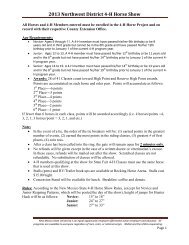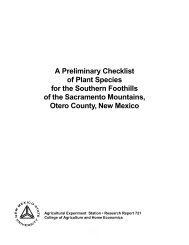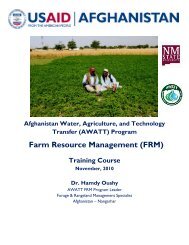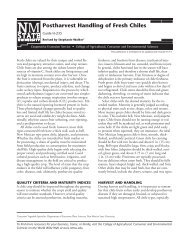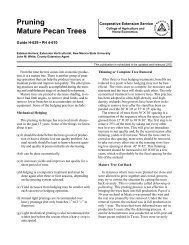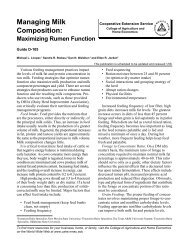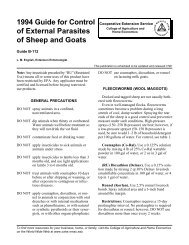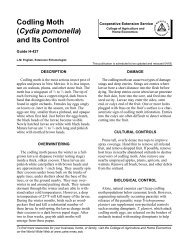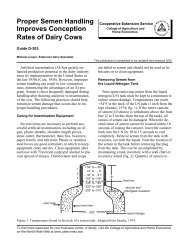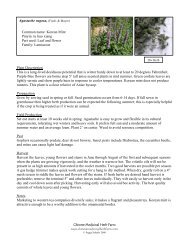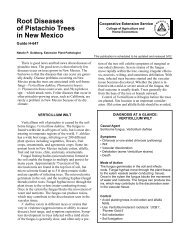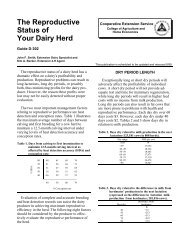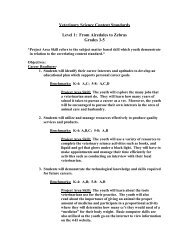PDF Version - NMSU's College of Agriculture and Home Economics ...
PDF Version - NMSU's College of Agriculture and Home Economics ...
PDF Version - NMSU's College of Agriculture and Home Economics ...
Create successful ePaper yourself
Turn your PDF publications into a flip-book with our unique Google optimized e-Paper software.
Appropriate Analyses for New Mexico SoilsGuide A-146Robert Flynn 1Cooperative Extension Service • <strong>College</strong> <strong>of</strong> Agricultural, Consumer <strong>and</strong> Environmental SciencesINTRODUCTIONSoil testing helps us underst<strong>and</strong> the soil environmentin which our plants must survive. A completeunderst<strong>and</strong>ing <strong>of</strong> the soil would includeits physical, chemical, <strong>and</strong> biological properties.Physical properties relevant to plant productioninclude soil texture, permeability, compaction,<strong>and</strong> water-holding capacity. Chemical propertiesinclude soil pH, salinity, <strong>and</strong> plant nutrients.Soil biology determines how efficiently nutrientsare released from organic matter, how well organicmatter is decomposed, <strong>and</strong> a host <strong>of</strong> otherproperties conducive to plant growth. Managementpractices affect all three <strong>of</strong> these categories.Soil testing provides a “snapshot” <strong>of</strong> whatconditions were like at the time <strong>of</strong> sampling,<strong>and</strong> this allows farmers <strong>and</strong> homeowners toplan their management practices for the cominggrowing season. Common questions like “Howmuch manure should I add?” or “What fertilizershould I use this year?” or “Do I need to lowermy soil pH?” can be answered with a soil test. Itis most common to focus on the chemical <strong>and</strong>physical properties <strong>of</strong> soil, but the biological aspectsare gaining more attention. Several tests have been developedto assess some <strong>of</strong> these properties. The USDANRCS’s Soil Quality Assessment webpage (http://soils.usda.gov/SQI/assessment/assessment.html) <strong>of</strong>fers someinsight into measuring certain biological properties.The focus <strong>of</strong> this publication is to provide guidancefor people interested in knowing more about their NewMexico soil from a chemical <strong>and</strong> physical perspective.OBTAINING A SAMPLEA soil test is only as good as the sample from which itcame. One core from the corner <strong>of</strong> a field, a fairway, orone’s front yard does not represent the whole field, golfcourse, or yard. Samples should be taken from areas thatcan be treated as distinct units (management zones).Figure 1. Feeling the soil while sampling can give informationabout soil moisture <strong>and</strong> texture across the area being sampled.The rough on a golf course differs from the green, <strong>and</strong>some areas cross soil type boundaries that vary greatlyin their physical <strong>and</strong> chemical properties. It usuallytakes 12 to 15 subsamples taken to the same depth <strong>and</strong>combined into one sample in order to be confident inthe soil test results from any given lab (Figure 1). Therecommended number <strong>of</strong> subsamples ensures that thesample is representative <strong>of</strong> a “management zone.” This isan area that may be treated the same with regard to watering,fertilizer application, <strong>and</strong> yield potential.The soil depth for sampling depends on tillage practices<strong>and</strong> the crop that is being grown. Areas that are nottilled, such as direct-seeded fields, orchards, vineyards,turfgrass, <strong>and</strong> perennial gardens, should be sampled toa depth <strong>of</strong> 6 to 8 inches. Any area that has been tilled,such as annual gardens, conventionally tilled productionfields, or similar areas, should be sampled to a1Extension Agronomist, Department <strong>of</strong> Extension Plant Sciences, New Mexico State University.To find more resources for your business, home, or family, visit the <strong>College</strong> <strong>of</strong> Agricultural, Consumer <strong>and</strong> EnvironmentalSciences on the World Wide Web at aces.nmsu.edu
depth <strong>of</strong> 12 inches. The second foot (12 to 24 inches),<strong>and</strong> deeper depths (>24 inches), <strong>of</strong> soil is <strong>of</strong>ten sampledto improve salinity <strong>and</strong> nitrogen management. Whensampling for soil analysis, it is important to brush aside orremove the surface layer <strong>of</strong> leaves <strong>and</strong> other plant residuesso that analytical results are more representative <strong>of</strong> stablesoil organic matter. The tool <strong>of</strong> choice is a probe that allowseasy soil retrieval without leaving behind a greatlydisturbed area. Some soils are too hard to easily push in aprobe, <strong>and</strong> a hammer is therefore necessary. Some probesare sold with “sliding-hammer” attachments that makesampling much easier. Spades are also a good tool, butyou should limit how much soil you collect in the samplingcontainer. For more information on proper samplingtechniques, please refer to Guide A-114, Test YourSoil (http://aces.nmsu.edu/pubs/_a/a-114.pdf). You canalso view a video on soil sampling at http://www.youtube.com/watch?v=aQMZ-MsYBiQ.WHAT ANALYSES TO REQUESTKey analyses that should be requested from any soiltesting laboratory include• pH,• electrical conductivity (EC),• sodium adsorption ratio (SAR),• organic matter (OM) or soil organic matter (SOM),• inorganic nitrogen (nitrate-N or ammonium-N),• phosphorus (P),• potassium (K),• texture, <strong>and</strong>• micronutrients such as iron (Fe), zinc (Zn),manganese (Mn), <strong>and</strong> copper (Cu).These tests are not unique to New Mexico, butwere used by the NMSU Soil, Water, <strong>and</strong> <strong>Agriculture</strong>Testing (SWAT) laboratory (closed in June 2012) on aroutine basis.There are specific ways the soil must be processedin the lab to obtain accurate results. Soil pH, electricalconductivity, <strong>and</strong> sodium adsorption ratio are determinedfrom a saturated paste extract. Organic matteris determined from a procedure known as the Walkley-Black method (as opposed to “combustion”). Inorganicnitrate-N can be determined by extracting the soil witha potassium chloride solution <strong>and</strong> testing for nitrate-Nafter cadmium reduction. Phosphorus is determinedafter extracting the soil with a solution <strong>of</strong> sodium bicarbonate(Olsen’s procedure) as long as the soil pHis above 7.2. A solution <strong>of</strong> ammonium acetate is usedto extract potassium. Micronutrients are required byplants in small quantities <strong>and</strong> can be evaluated for plantavailability by extracting with a DTPA solution. Othernutrients to consider include sulfate <strong>and</strong> boron. Pleaseconsult Circular 650, Sulfur <strong>and</strong> New Mexico <strong>Agriculture</strong>(http://aces.nmsu.edu/pubs/_circulars/CR-650.pdf),for more information regarding the need for sulfate.Boron is <strong>of</strong>ten sold but seldom needed in New Mexico<strong>and</strong> should only be considered if plants exhibit deficienciesor tissue testing reveals low boron levels within theplant. Boron can be toxic to plants if applied at toogreat a concentration. The amount <strong>of</strong> soil lime presentin the sample is also helpful when considering whatplants to grow.Saturated Paste Extract (Method S – 1.10 inGavlak et al. [2005])In this test method, soil samples are ground <strong>and</strong> passedthrough a 2-mm sieve, then just enough water is addedto make a paste that glistens but does not flow from acup. Soil texture greatly influences the amount <strong>of</strong> waterthat can be added to make it “saturated.” Soils with highamounts <strong>of</strong> clay <strong>of</strong>ten take 24 hours to fully absorb theadded water. Once 24 hours have passed <strong>and</strong> the sampleis saturated, the soil is placed under suction <strong>and</strong> the liquidis removed for further testing. This sample is knownas the saturated paste extract <strong>and</strong> most closely resemblesconditions after an irrigation. Soil pH, EC, <strong>and</strong> SAR(relative amount <strong>of</strong> calcium, magnesium, <strong>and</strong> sodium)are determined from the saturated paste extract.Soil pHSoil pH is a measure <strong>of</strong> the soil’s acidity or basicity (alkalinity).A substance is acidic if the pH is below 7.0<strong>and</strong> alkaline if the pH is above 7.0. A neutral soil has apH <strong>of</strong> 7.0. Technically, soil pH is the negative logarithm<strong>of</strong> the hydrogen ion activity (-log 10(H + )). Commonhousehold items that are acidic include vinegar, cola,<strong>and</strong> c<strong>of</strong>fee, while antacids, detergents, <strong>and</strong> bleach arebasic (alkaline). Ideally, soil pH should be near 6.5 inorder to keep phosphorus in its most available form.Many micronutrients, such as iron <strong>and</strong> zinc, are alsomore available to the plant at a 6.5 soil pH. Other nutrientsfor plant growth are strongly affected by soil pH.Only nitrogen, potassium, <strong>and</strong> sulfur are unaffected bysoil pH. Soil pH in New Mexico is normally between6.5 <strong>and</strong> 8.4. Mountain soils, where more rain occurs,generally have a soil pH below 7.0. Many garden soilsthat have received too much organic matter may alsohave a lower soil pH, but not always. Soil pH should bedetermined from a saturated paste extract (pH s).It is also helpful to know the soil lime content in caseswhere gypsum is recommended as a reclamation tool.Elemental sulfur can be used in place <strong>of</strong> gypsum in situationswhere there is elevated sodium with lime (calciumcarbonate) present in the soil.Guide A-146 • Page 2
Calcium CarbonateFor much <strong>of</strong> New Mexico, soil pH is controlled by thepresence <strong>of</strong> lime (calcium carbonate). Lime acts as a bufferagainst changes in soil pH <strong>and</strong> can tie up phosphorus<strong>and</strong> iron, making them unavailable for plants. Thepercentage <strong>of</strong> calcium carbonate in soil can be determinedat a soil testing lab. You can do a quick home testfor the presence <strong>of</strong> lime using household vinegar. Simplypour a little vinegar on the soil. Lime is present if thesoil fizzes when exposed to vinegar.A soil with 5% lime in the top 6 inches has approximately2,296 pounds <strong>of</strong> lime per 1,000 square feet. Soilswith more than 3% lime are most likely to have a pHabove 7.5. All <strong>of</strong> this lime must be neutralized beforethe soil pH can be lowered. Elemental sulfur is a commonamendment used to lower soil pH. However, thepresence <strong>of</strong> soil lime will prevent any change until thelime has been eliminated. It is <strong>of</strong>ten more economical toestablish plants that are tolerant <strong>of</strong> alkaline soils <strong>and</strong> arenot sensitive to soil lime. (Refer to the National PlantsDatabase at http://plants.usda.gov for more informationregarding plant tolerance to alkaline soils).Electrical Conductivity (EC e) (Method S – 1.20in Gavlak et al. [2005])Total soil salts are determined from the saturated pasteextract to classify the soil as saline or nonsaline. Unitsare in mmhos/cm or dS/m. Electrical conductivityshould be determined from a saturated paste extract(EC e) for best correlation to plant performance. A salinesoil has a conductivity greater than 4 mmhos/cm. Specialmanagement practices are necessary when soils testas saline. Salinity is more fully described in Circular 656,An Introduction to Soil Salinity <strong>and</strong> Sodium Issues in NewMexico (http://aces.nmsu.edu/pubs/_circulars/CR656.pdf). Instead <strong>of</strong> EC, many growers prefer to use partsper million total dissolved solids (ppm TDS) to indicatesalinity. To calculate the ppm TDS, multiply EC by 640.Sodium Adsorption Ratio (SAR) (Method S –1.60 in Gavlak et al. [2005])The liquid from the saturation extract is also used todetermine the calcium, magnesium, <strong>and</strong> sodium in thesoil to assess water infiltration hazards due to too muchsodium. Gypsum recommendations are made using thisparameter. For more discussion about SAR, see Circular 656,An Introduction to Soil Salinity <strong>and</strong> Sodium Issues in NewMexico (http://aces.nmsu.edu/pubs/_circulars/CR656.pdf)Soil Organic Matter (SOM) (Method S – 9.10 inGavlak et al. [2005])The Walkley-Black procedure is suggested as a goodmeasure <strong>of</strong> organic matter for New Mexico soils. Soil organicmatter is more than the presence <strong>of</strong> compost <strong>and</strong>roots in the soil. Thirty pounds <strong>of</strong> plant-available nitrogenare credited to the soil for every 1% organic matterin the top foot <strong>of</strong> soil as determined by the Walkley-Black procedure. Knowledge <strong>of</strong> the soil organic mattercontent helps underst<strong>and</strong> possible causes for salinity,improved water-holding capacity, <strong>and</strong> improved nutrientreserves. Organic matter benefits soil <strong>and</strong> crops by• Helping strengthen soil aggregates, which improvessoil tilth <strong>and</strong> structure.• Improving aeration <strong>and</strong> water infiltration.• Increasing water-holding capacity (0.08 to 0.19 inchesper 1% SOM).• Providing a significant number <strong>of</strong> nutrient exchangesites.• Buffering against rapid changes in soil pH.• Forming stable organic compounds that can increasemicronutrient availability.• Providing a source <strong>of</strong> plant nutrients (0.7 pounds Nper 1,000 square feet per year per 1% SOM per foot<strong>of</strong> soil).• Providing a food source <strong>and</strong> ecosystem for soil microorganismsas well as earthworms <strong>and</strong> other beneficialorganisms.Nutrient AnalysesThree primary nutrients should be evaluated on aroutine basis: inorganic-N, phosphorus, <strong>and</strong> potassium.Four micronutrients analyses that are routinelyrequested are iron, zinc, copper, <strong>and</strong> manganese. Thenutrients are interpreted according to the likelihood thatplants would respond to additional fertilizer. A soil thatis ranked low means there is not enough <strong>of</strong> that nutrientfor the plant to grow correctly <strong>and</strong> that the plant wouldbenefit from an application <strong>of</strong> that nutrient. If the nutrientis ranked high there is little chance the plant wouldrespond to additions <strong>of</strong> that nutrient (i.e., it would be awaste <strong>of</strong> money to add more).Inorganic Nitrogen (N) (Method S – 3.10 inGavlak et al. [2005])Inorganic-N is the sum <strong>of</strong> nitrate-N <strong>and</strong> ammonium-N in the soil. Nitrate-N is usually more prevalent <strong>and</strong>may be the only form tested by some labs. Severalmethods exist, but a common procedure uses potassiumchloride (KCl) to extract the inorganic-N fromthe soil. The amount <strong>of</strong> fertilizer nitrogen neededis based on the amount <strong>of</strong> nitrogen in the soil <strong>and</strong>the amount <strong>of</strong> nitrogen required to adequately promotegrowth <strong>and</strong> performance <strong>of</strong> a given crop. Fastgrowingplants generally require more nitrogen thanslow-growing plants. Nitrogen fertilizer applicationsmay be eliminated (at first) if the soil test is ratedhigh for inorganic-N. Fertilizer should be appliedwhen temperature <strong>and</strong> moisture conditions favor activegrowth; they should not be applied during times<strong>of</strong> stress. Heavy rains or excessive irrigation will lowerGuide A-146 • Page 3
the nitrate-N content <strong>of</strong> the soil via leaching. Samplestaken before a leaching event will overestimatethe soil inorganic-N <strong>and</strong> subsequently underestimatethe amount <strong>of</strong> nitrate-N that would be needed for apotential crop.Phosphorus (P) (Method S – 4.10 in Gavlak etal. [2005])Western soils are typically alkaline <strong>and</strong> should haveplant-available phosphorus determined using a sodiumbicarbonate solution (Olsen’s procedure). Thisextract has been shown to correlate very well withplant-available phosphorus in high-pH (alkaline)soils. New Mexico soils that are low in organic matterusually are also low in plant-available phosphorus.Soil chemistry in New Mexico favors the creation<strong>of</strong> apatite (a calcium phosphate mineral) that is notavailable for plants to use. As a result, plant-availablephosphorus is usually quite low in alkaline soils <strong>and</strong>should be supplemented for growing plants. Phosphorusfertilizers can be applied at 1/5th the nitrogenrate when making routine applications.Potassium (K) (Method S – 5.10 in Gavlak et al.[2005])The accepted method for determining plant-availablepotassium is extracting the soil with an ammonium acetatesolution. Before NMSU’s SWAT laboratory closedthey used water-extractable potassium, which is a fraction<strong>of</strong> the extractable potassium for most soils. However,the value <strong>of</strong> one method over another is related tounderst<strong>and</strong>ing <strong>of</strong> plant response to reported values. Lowpotassium, as well as other nutrient levels that are reportedlow, will generally mean a good chance for plantresponse to added fertilizer.Micronutrients (Method S – 6.10 in Gavlak etal. [2005])Iron (Fe): Iron is extracted with DTPA (a chelate) bymost soil testing labs in the West. Iron deficiencies canoccur with sensitive plants grown in alkaline or calcareoussoil. If the soil pH is above 7.5, less iron is availableto the plant because the chemistry <strong>of</strong> the soil favors thecreation <strong>of</strong> a mineral form <strong>of</strong> iron that is not availablefor plant use. Even though a soil may test high in availableiron, iron-sensitive crops may still exhibit deficiencysymptoms. Chelates <strong>of</strong>ten are used to keep iron fertilizersin a more available form, but care should be taken topick EDDHA or DTPA as the chelate <strong>of</strong> choice in NewMexico instead <strong>of</strong> EDTA. EDDHA is most stable acrossall soil pH ranges, while DTPA should not be used insoil with a pH above 7.6. These two classes <strong>of</strong> chelateswill generally improve iron nutrition in plants.Zinc (Zn): Zinc, like iron, is extracted with DTPA bymost labs in the West. Zinc can be an economic problemfor many crops like corn, sorghum, <strong>and</strong> pecans. Zincis most unavailable in soils with pH greater than 7.5. Extremelyhigh levels <strong>of</strong> phosphorus can cause zinc deficienciesby competing for adsorption sites on the soil. Soil testresults are classified as low, medium, or high.Copper (Cu): Copper deficiencies have not been verifiedin New Mexico soils. Factors that contribute to copperdeficiency are high organic matter, s<strong>and</strong>y textural class,<strong>and</strong> very high pH. Copper toxicities, on the other h<strong>and</strong>,have been an issue in some New Mexico fields that havebeen treated with copper-containing amendments.Manganese (Mn): Manganese deficiencies have begunto show up in pecans <strong>and</strong> some other crops in NewMexico. Deficiency symptoms can occur under the sameconditions that promote iron <strong>and</strong> zinc deficiencies.Boron (B) (Method S – 7.10 in Gavlak et al. [2005]):Boron is another micronutrient that is needed by plantsbut is usually sufficient in soils in low rainfall areas.Plant tissue testing can indicate whether or not there issufficient boron available to the plant. Some plants suchas pistachios can exhibit boron deficiency. Soil levels areassessed using a hot water extract <strong>of</strong> the soil. Treatingplants or soil with boron should be approached withcaution because <strong>of</strong> the potential for boron toxicity ifover-applied.Sulfate (SO 4-S) (Method S – 11.10 in Gavlak et al.[2005]): S<strong>and</strong>y soils are prone to sulfur deficiencies.However, addition <strong>of</strong> organic matter, sulfate-containingfertilizers, <strong>and</strong> irrigation water <strong>of</strong>ten supplies enoughfor crop needs. For more information on sulfur in NewMexico, see Circular 650, Sulfur <strong>and</strong> New Mexico <strong>Agriculture</strong>(http://aces.nmsu.edu/pubs/_circulars/CR-650.pdf).Soil Texture (Method S – 14.10 in Gavlak et al.[2005], or Thien [1979])Soils are composed <strong>of</strong> mineral particles with an infinitenumber <strong>of</strong> sizes <strong>and</strong> shapes. Individual mineral particlesare divided into three major categories based on theirsize: s<strong>and</strong>, silt, or clay. Many <strong>of</strong> soil’s important physical<strong>and</strong> chemical properties are associated with the surface<strong>of</strong> these particles. Soil texture is most <strong>of</strong>ten estimated bythe “feel” method, but sieves or hydrometer readings canbe requested, usually at a much higher price. Soil texturegives a preliminary indication about the soil’s waterholdingcapacity.Guide A-146 • Page 4
LABORATORIESSoils are complex biological, chemical, <strong>and</strong> physical systems.Diligence in interpreting soil test results can savehundreds <strong>of</strong> dollars every year. The only way to knowwhat a soil is truly like is to start with a soil sample. Severalcommercial labs are given in Table 1 with a listing<strong>of</strong> test packages or names that would be useful for interpretation<strong>of</strong> New Mexico soils. Be aware that proceduresshould be similar to those suggested in this document.Individual labs vary in services <strong>of</strong>fered, prices, <strong>and</strong> thetime they require for analyses. The list <strong>of</strong> laboratories inTable 1 is not all-inclusive, <strong>and</strong> the list <strong>of</strong> services maychange over time. To select a lab, consider convenience,services <strong>of</strong>fered, <strong>and</strong> quality. Consider using laboratoriesthat participate in the North American Pr<strong>of</strong>iciency TestingProgram (Table 1). This program assists soil, plant,<strong>and</strong> water testing laboratories in their performancethrough inter-laboratory sample exchanges <strong>and</strong> a statisticalevaluation <strong>of</strong> the analytical data.QUALITY ASSURANCESoils are heterogeneous, <strong>and</strong> replicates <strong>of</strong> the samesample will never have the exact same analytical resultfrom one laboratory to another. The North AmericanPr<strong>of</strong>iciency Testing Program guidelines have been developedfor the agricultural laboratory industry by representativesfrom groups familiar with <strong>and</strong> involved inst<strong>and</strong>ardizing methods <strong>and</strong> developing nutrient recommendationsfor soil <strong>and</strong> plant analysis methods withinthe U.S. <strong>and</strong> Canada. It is operated as an activity <strong>of</strong>the Soil Science Society <strong>of</strong> America <strong>and</strong> overseen by anoversight committee comprising representatives <strong>of</strong> theaforementioned groups. These include regional soil <strong>and</strong>plant analysis workgroups, scientific organizations, state/provincial departments <strong>of</strong> agriculture, <strong>and</strong> private <strong>and</strong>public plant analysis labs.Finally, keep a record <strong>of</strong> your lab results. If you needhelp interpreting the results, please consult with yourNew Mexico State University Cooperative ExtensionService county <strong>of</strong>fice.REFERENCESFlynn, R.P., <strong>and</strong> A.L. Ulery. 2011. An introduction tosoil salinity <strong>and</strong> sodium issues in New Mexico [Circular656]. Las Cruces, NM: New Mexico State UniversityCooperative Extension Service. Available at http://aces.nmsu.edu/pubs/_circulars/CR656.pdfFlynn, R.P., A.L. Ulery, <strong>and</strong> W.C. Lindemann. 2010.Sulfur <strong>and</strong> New Mexico agriculture [Circular 650]. LasCruces, NM: New Mexico State University CooperativeExtension Service. Available at http://aces.nmsu.edu/pubs/_circulars/CR-650.pdfGavlak, R.G., D.A. Horneck, <strong>and</strong> R.O. Miller. 1994.Plant, soil <strong>and</strong> water reference methods for the WesternRegion [WREP 125]. Fairbanks, AK: University <strong>of</strong>Alaska.Glover, C.R., <strong>and</strong> R.D. Baker. 2000. Test your soil[Guide A-114]. Las Cruces, NM: New Mexico StateUniversity Cooperative Extension Service. Availableat http://aces.nmsu.edu/pubs/_a/a-114.pdfThien, S.J. 1979. A flow diagram for teaching textureby feel analysis. Journal <strong>of</strong> Agronomic Education, 8,54–55USDA–NRCS. n.d. Soil quality / soil health assessment[Online]. Available at http://soils.usda.gov/sqi/assessment/assessment.htmlRobert Flynn is an AssociatePr<strong>of</strong>essor <strong>of</strong> Agronomy <strong>and</strong> Soils<strong>and</strong> an Extension Agronomistat New Mexico State University.He earned his Ph.D. atAuburn University. His research<strong>and</strong> Extension efforts aim toimprove grower options thatlead to sustainable productionthrough improved soil quality,water use efficiency, <strong>and</strong> cropperformance.FOR FURTHER ASSISTANCEClientele are encouraged to contact their county Extensionagent with specific questions, or Dr. Robert Flynn,who has assisted with soil test interpretations in NewMexico, at rflynn@nmsu.edu or 575-748-1228.Guide A-146 • Page 5



